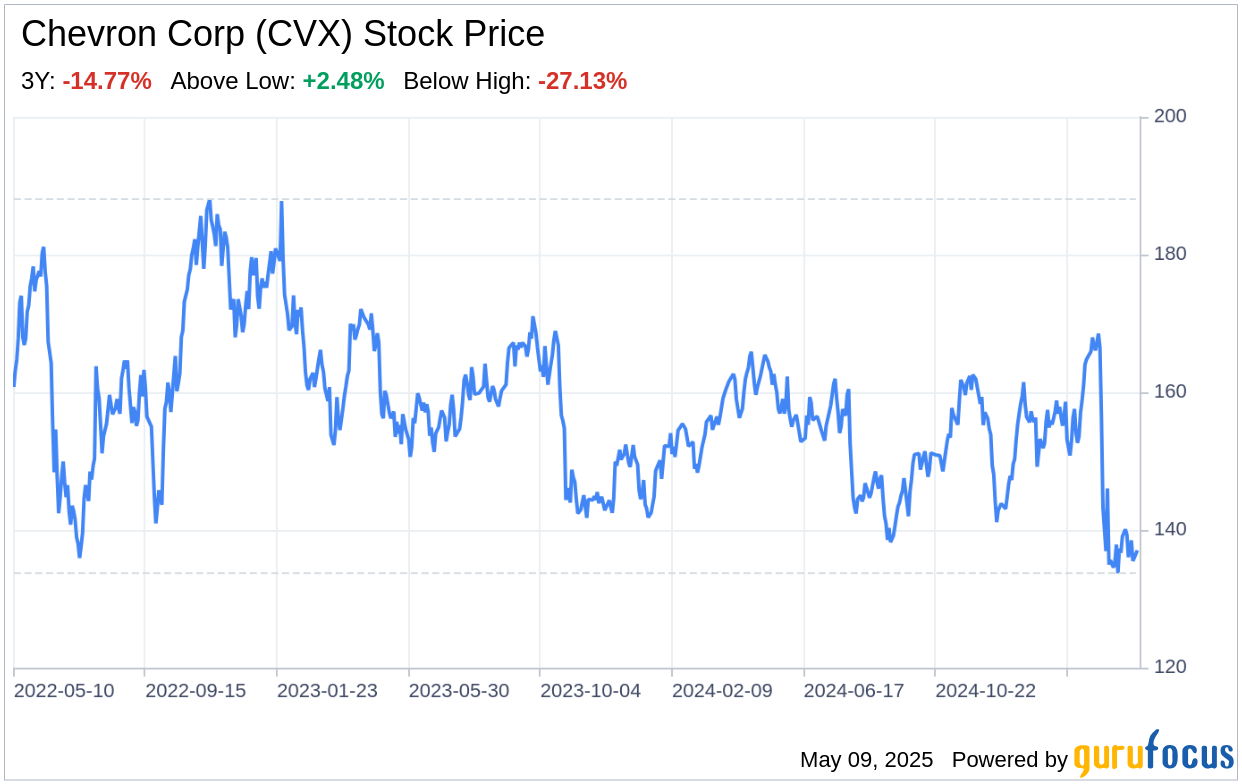On May 8, 2025, Chevron Corp (CVX, Financial), an integrated energy giant, filed its 10-Q report with the SEC, revealing a mix of financial results that reflect the company's operational and market challenges. Chevron reported a decline in net income to $3.5 billion in the first quarter of 2025, down from $5.5 billion in the same period last year. This decrease was primarily due to lower sales and other operating revenues, which dipped to $46.1 billion from $46.6 billion, alongside a notable drop in income from equity affiliates. Despite these challenges, Chevron maintains a robust financial position, with a strong balance sheet and significant reserves, positioning it well for future growth and stability in the volatile energy sector.

The following SWOT analysis delves into the strengths, weaknesses, opportunities, and threats facing Chevron Corp, as derived from its recent financial filings and market performance.
Strengths
Robust Production and Reserve Base: Chevron Corp stands out with its impressive production of 3.0 million barrels of oil equivalent per day and a proven reserve base of 9.8 billion barrels of oil equivalent. This vast reserve base ensures long-term sustainability and the ability to meet global energy demands, a significant competitive advantage in the energy sector.
Global Operational Footprint: With operations spanning North America, South America, Europe, Africa, Asia, and Australia, Chevron's global presence allows for diversified risk and access to various markets. This geographical spread mitigates the impact of regional volatility and positions Chevron to capitalize on regional growth opportunities.
Financial Resilience: Despite a downturn in net income, Chevron's financials remain solid, with a diluted earnings per share of $2.00. The company's ability to maintain profitability in a challenging environment underscores its financial resilience and operational efficiency.
Weaknesses
Dependence on Commodity Prices: Chevron's earnings are highly sensitive to crude oil prices, which are subject to global market fluctuations. The recent decline in net income can be partly attributed to lower realizations, highlighting the company's vulnerability to price volatility.
Operational Challenges: The company faces operational challenges, such as the need for substantial capital investments in projects like the Tengizchevroil LLP (TCO) in Kazakhstan. While these projects promise future growth, they also require significant upfront costs and carry execution risks.
Regulatory and Environmental Pressures: Chevron must navigate complex regulatory environments and increasing environmental scrutiny. The company's involvement in areas like Venezuela also presents geopolitical risks that can impact operations and profitability.
Opportunities
Energy Transition and Diversification: Chevron is well-positioned to lead in the energy transition with investments in renewable fuels, carbon capture, hydrogen, and other emerging technologies. This diversification strategy can open new revenue streams and reduce carbon intensity.
Strategic Acquisitions: The planned acquisition of Hess Corporation indicates Chevron's strategic intent to expand its asset base and enhance shareholder value. Successful integration of Hess could bolster Chevron's market position and operational capabilities.
Cost Reduction Initiatives: Chevron's commitment to achieving $2-3 billion in structural cost reductions by the end of 2026 presents an opportunity to improve margins and competitiveness through operational efficiencies and technology adoption.
Threats
Market and Economic Uncertainty: The energy sector is susceptible to economic downturns, policy changes, and market disruptions. Chevron's recent decline in net income reflects these broader market challenges that can adversely affect future performance.
Climate Change and Policy Risks: Chevron must contend with the evolving landscape of climate change policies and regulations, which could impose additional costs and necessitate changes in business operations.
Competition and Technological Advancements: Intense competition from both traditional energy companies and new entrants in the renewable sector, coupled with rapid technological advancements, could erode Chevron's market share if it does not innovate and adapt swiftly.
In conclusion, Chevron Corp (CVX, Financial) exhibits a strong foundation with its extensive production capabilities, global reach, and financial stability. However, it must address vulnerabilities related to commodity price dependence and operational challenges. The company's proactive approach to the energy transition, strategic acquisitions, and cost reduction initiatives positions it to seize opportunities in a changing energy landscape. Nevertheless, Chevron must remain vigilant against market uncertainties, climate policy risks, and competitive forces to maintain its industry leadership and drive shareholder value.
This article, generated by GuruFocus, is designed to provide general insights and is not tailored financial advice. Our commentary is rooted in historical data and analyst projections, utilizing an impartial methodology, and is not intended to serve as specific investment guidance. It does not formulate a recommendation to purchase or divest any stock and does not consider individual investment objectives or financial circumstances. Our objective is to deliver long-term, fundamental data-driven analysis. Be aware that our analysis might not incorporate the most recent, price-sensitive company announcements or qualitative information. GuruFocus holds no position in the stocks mentioned herein.
